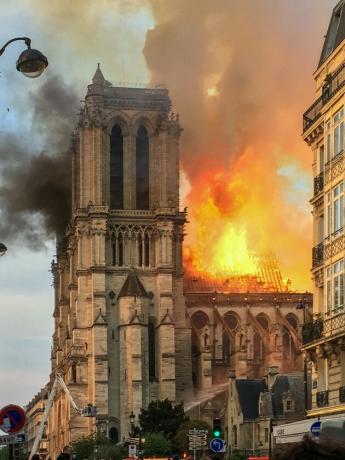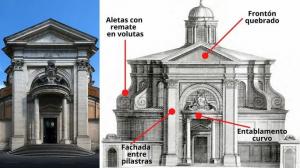Notre Dame de Paris cathedral: history, characteristics and meaning
The cathedral of Notre Dame or Our Lady of Paris, represents the French Gothic style in all its splendor. Construction began in 1163, and since then, it is a fundamental reference of Western culture. For this reason, this cathedral is part of the UNESCO World Heritage catalog.
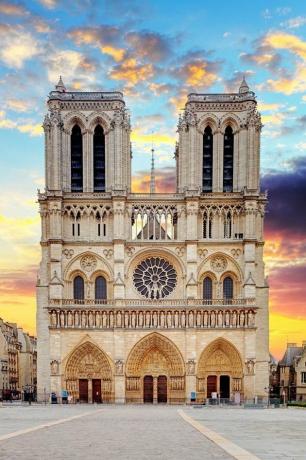
After more than 850 years of existence, Notre Dame de Paris has persisted as a living space. Its spiritual functions have remained intact, while it has received an average of 20 million visitors each year, at least until the regrettable fire of April 15, 2019, which forced the temporary cessation of her functions for restoration.
Although the majority of tourists are satisfied with the usual photo, there are always those who stop to discover what is hidden behind that "stone lady", as many call her. Who made it possible and where did they find the encouragement for such a work? What characterizes it? What is its meaning?
Characteristics of the cathedral of Notre Dame
The cathedral of Notre Dame
de Paris was built in the middle of narrow streets and many houses, nothing to do with the open space that surrounds it today. Any mortal who appeared at the door of his house before the nineteenth century, would immediately feel the undeniable grandeur of that mass full of symbols, legends and stories.Therefore, the first outstanding characteristic of this work is its monumentality and its symbolic power, but in honor of the truth, this is how Gothic art used to be. With a theocentric worldview, every space in a Gothic building was diligently cared for and, Although it did not have a function, it received the careful attention of artisans who believed that God watched.
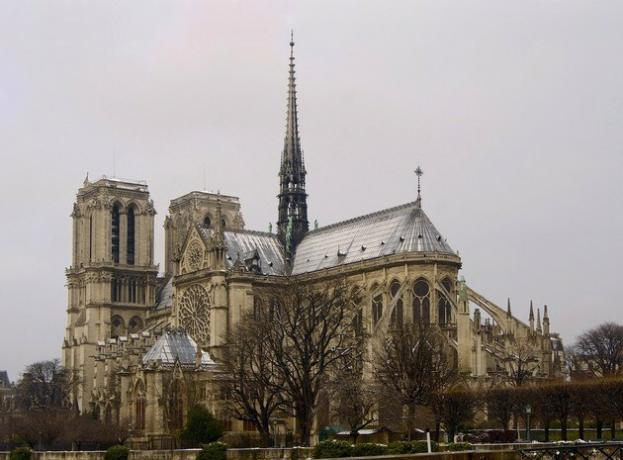
It is not surprising the profusion of unique details in each section, even those inaccessible or without a defined purpose. That generation did not care that the human eye saw the details of the effort, it hardly mattered that the Eternal saw it. The mentality of her builders was this: give all dignity to the work as an offering to God. That is why Gothic art is a stone prayer.
The prayer begins from the moment the cathedral is dedicated to the Virgin Mary or Notre Dame (Our Lady, in French). The Marian cult reached its highest point in those years. Mary, the mother of God, found resonance in a society in which women, increasingly lonely because of the Crusades, were involved in spirituality in a different way.
This coincided with the birth of theological humanism, which gave way to the perception of a closer God and the vindication of the sensible world (creation) as an expression of divine light.
Prayer is expressed both in the new architectural resources that sought light and height and in the plastic arts integrated into the building. Rib vaults, buttresses, flying buttresses (created precisely for Notre Dame), stained glass windows and rose windows joined the power of an increasingly naturalistic art, which made it possible to express the renewed faith of the people towards their God.
Plant
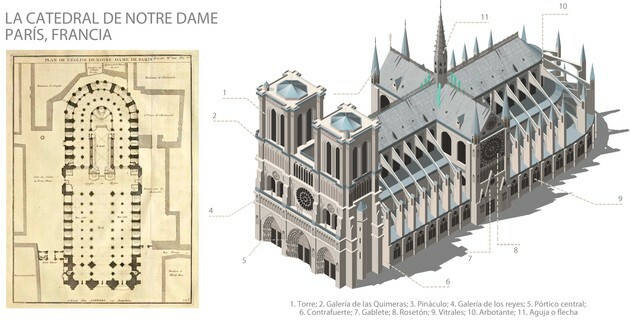
The floor of the cathedral Notre Dame It is shaped like a Latin cross. The main nave is a total of 127 meters long and 48 wide. The particularly short transept is 14 meters wide and 48 meters long, that is, the same measure as the width of the nave. There is a main nave and 4 lateral ones, for a total of 5 naves with double ambulatory. In turn, the building reaches a maximum height of 96 meters on the needle and a total area of 5500 m².
See also Gothic art: characteristics and main works.
Main facade
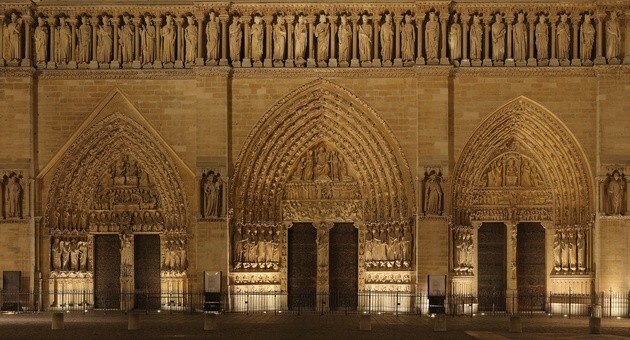
The western facade of Notre Dame It is basically made up of three horizontal sections. At its base, three porticoes prepare the entrance of the faithful to an absolutely captivating interior space. The three porticoes, although similar, differ in creation processes, dimensions and themes, as expressed in the respective eardrums.
Tympanum of Santa Ana
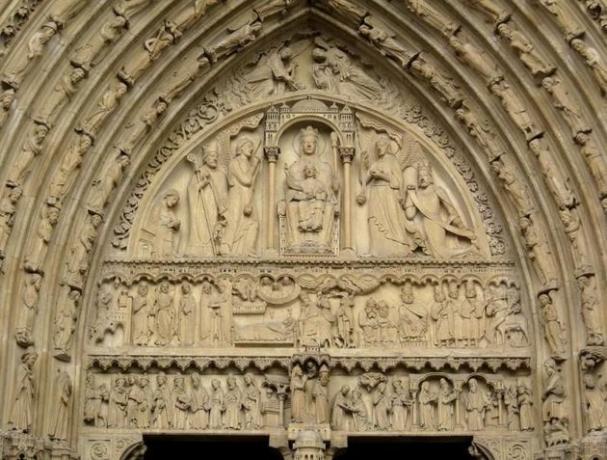
The first tympanum (left) is dedicated to Santa Ana, mother of Mary. Much of the tympanum is not original, but was recovered from another church and reused. This explains the hieratic of the upper section of the tympanum, typical of the late Romanesque style. Thus, the Virgin Mary, arranged as the theotokos, looks rigid on her throne with the child.
In the middle strip you can see the representation of the life of Mary and, in the lower one, the representation of Santa Ana and San Joaquin. The stories of Santa Ana and San Joaquin, as well as the childhood of Mary, were then documented in the light of the apocryphal gospels.
Tympanum of the Last Judgment
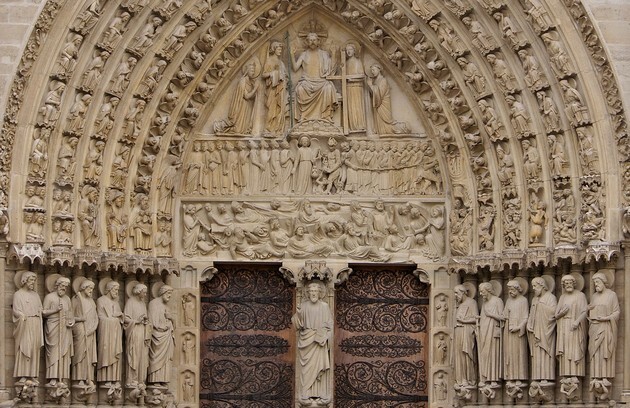
The central portico is dedicated to the Last Judgment. Christ as judge presides over the tympanum in the upper band, flanked by two angels on each side, and next to them, Saint John (right) and the Virgin Mary (left). In the middle strip you can see the elect wearing a crown. On the contrary, the damned. In the center of the strip, the archangel Saint Michael carries the scales of justice, while a demon tries to tip it in his favor.
The lower strip represents the resurrection of the dead at the end of time and was rebuilt by the architect Eugène Viollet-Le-Duc in the 19th century. Each character is dressed with the attributes of his occupation or occupation. In the mullion we see Christ blessing. On the side jambs, the apostles complete the group. Below each of them, the zodiac signs are represented.
Meanwhile, the archivolts of the tympanum are allegorical elements of heaven and hell. We can see the demons torturing the souls on the right side, at the level of the lower band of the eardrum. On the left side we see the representation of the blessed as children. In the rest of the archivolts, angels, patriarchs and saints.
Tympanum of Our Lady
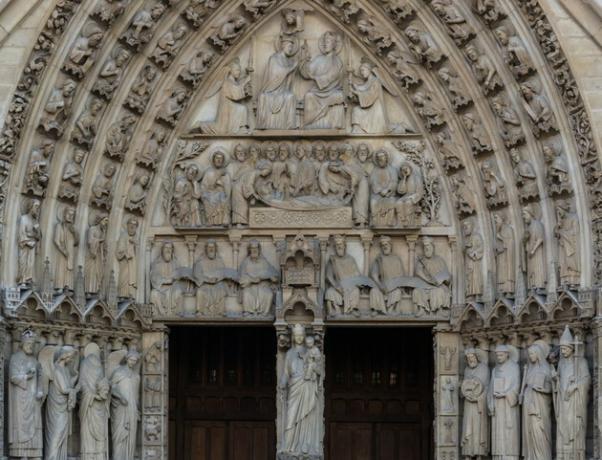
This section suffered major mutilations during the French Revolution, and had to be restored in the 19th century. The door is dedicated to the Virgin Mary. It is presided over by the scene of the coronation of the Virgin in the upper strip.
In the middle strip, the sleeping of Mary is represented, who lies on a bed accompanied by the apostles, while the angels raise her soul to heaven. In the lower strip, the patriarchs who hold or guard a canopy with the ark of the covenant and the tables of the law.
In the mullion, the Virgin Mary appears with the Holy Child in her arms. On the jambs, various characters such as kings or patriarchs. On the left stands out the representation of Saint Denis, who holds his head in his hands, alluding to his martyrdom.
Gallery of the kings and gallery of the chimeras (gargoyles)

The gallery of the kings, located in the middle section of the western facade, was elaborated in the Middle Ages, and represents a sculptural group of 28 royal figures from Judea and Israel. The gallery of the kings, like part of the porticoes, suffered important destruction in times of the French Revolution, since the revolutionaries thought that the characters were the kings of France.
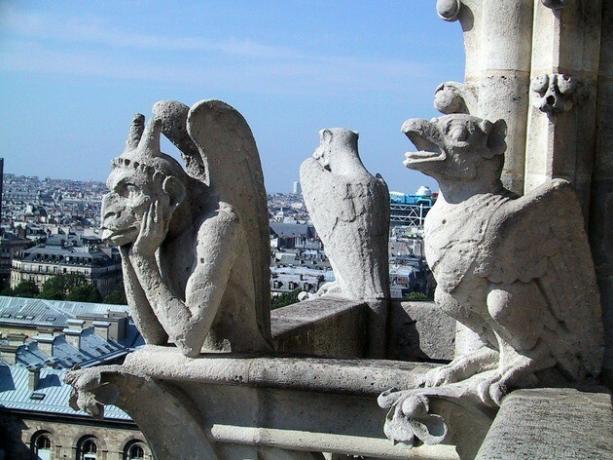
The architect Eugène Viollet-leDuc, who, as we have seen, was commissioned to restore the cathedral, did not limit himself to a restoration. He also created and recreated new elements. On the one hand, Viollet-le-Duc incorporated his face into one of the portraits of the kings. On the other hand, using his imagination and based on the romanticist fantasy of the 19th century, the architect adapted the remains of the gallery of gargoyles to monstrous and fantastic figures.
North side
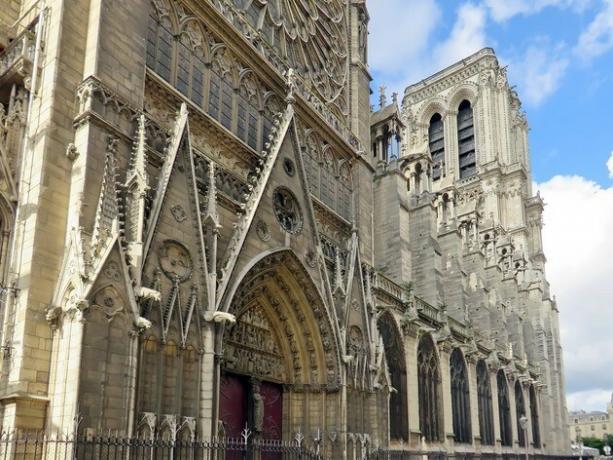
On the north façade, oriented towards the rue du Cloitre, we see one of the doors of the transept. The portico is framed by a gable, a type of triangular and banded finish, which is often used to decorate the openings and windows of Gothic churches. In this case, each façade has a set of three gables, duly ranked.
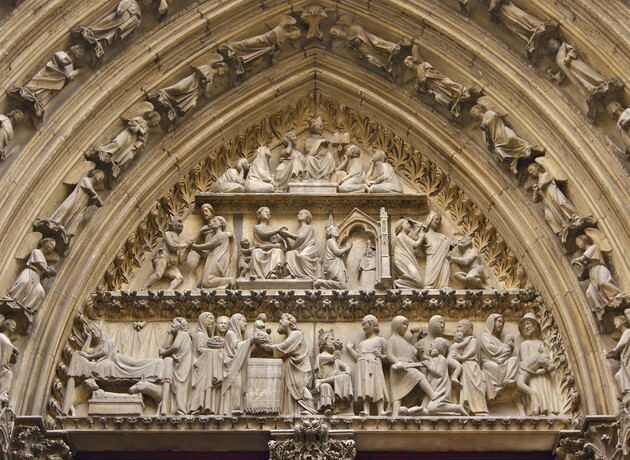
In the portico, the Virgin with the Child is represented in the mullion, but the sculpture is incomplete. The tympanum is dedicated to the monk Theophilus of Adana, whose story represents the upper and middle stripes.
The story goes that Theophilus of Adana was a monk who had been commissioned to become abbot, but preferred to remain archdeacon. The new abbot removed him from his post and Teófilo, desperate, made a pact with the devil with the help of a Jew, in order to impose himself on the abbot. Seeing the damage he had done, Theophilus repented and freed himself by the help of the Virgin Mary.
In the lower register or strip, the childhood of Jesus is represented: his birth, his presentation in the temple of Jerusalem, the slaughter of the innocents and the flight to Egypt.
South Facade
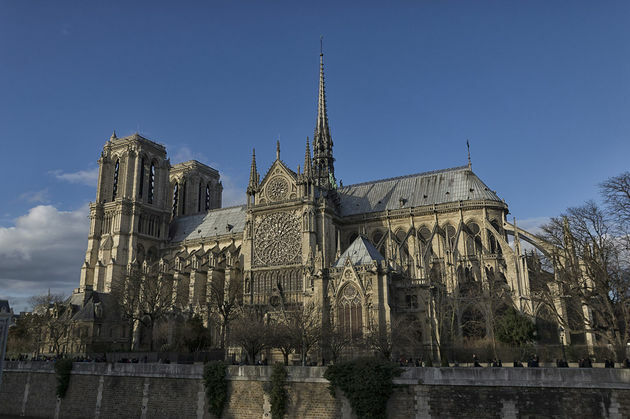
Like the north facade, the portico of the south facade, the other end of the transept, is crowned by a gable. The portico dedicated to San Esteban and, like all the previous ones, is made up of three registers. In the upper register, Jesus can be seen with his angels contemplating the martyrdom of Saint Stephen. The lower registers relate the life and martyrdom of Saint Stephen.
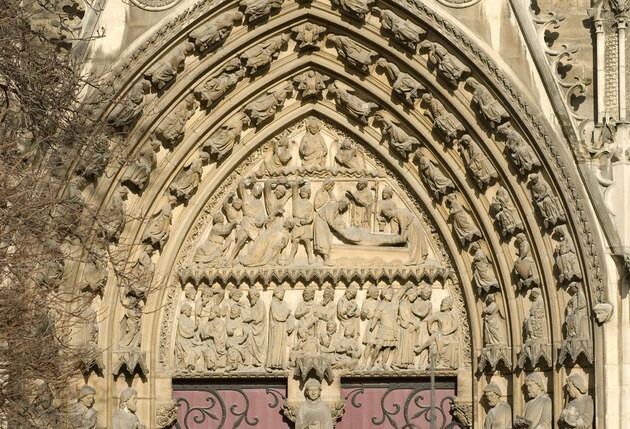
The red door
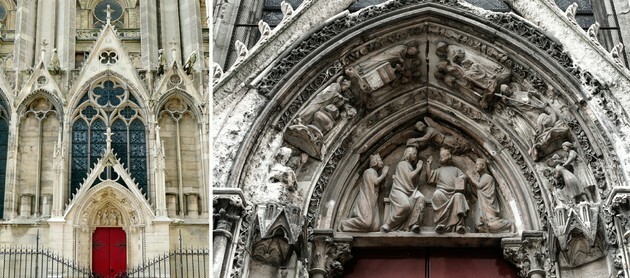
The Red Door It is a door used in Notre Dame to facilitate the passage of the religious from the cloister towards the church and, particularly, towards the choir area, in order to celebrate the "matins" in the early hours of the morning. It was built in the 13th century and is crowned by a complex of gables. Since its use is "internal", the door is smaller than the others and the eardrum is simpler.
Attributed to the master Pierre de Montreuil, the tympanum is dedicated to the coronation of the Virgin Mary. At each end of the tympanum appear the donors who financed it: King Saint Louis and Queen Margaret of Provence, his wife.
Around the tympanum there is a single archivolt in honor of San Marcelo (Saint Marcel), bishop of Paris around the 4th century, whose reliquary was kept in the cathedral until the French Revolution. His life is represented in different scenes that begin with baptism by immersion, and include some popular legends, like the one according to which Marcel would have defeated a dragon that devoured women of disrepute, just with his bishop.
The ceiling and the spire
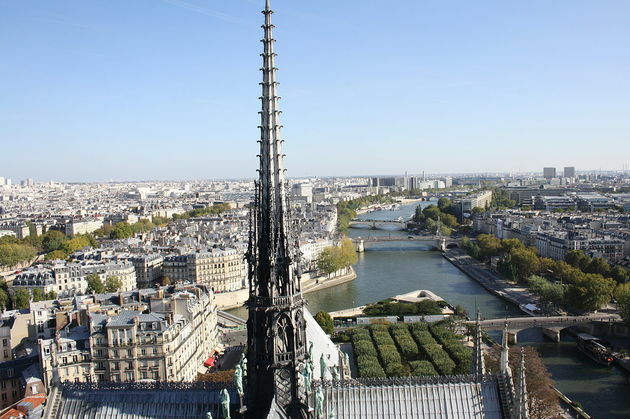
The roof of Notre Dame it is supported by a wooden frame that receives the name of "the forest of Notre Dame". The reason for this name is found not only in the number of beams, but in that each of them was a tree of whole oak, many of them hundreds of years old.

On the roof of the cathedral of Notre Dame highlights the needle. This needle was added in the 19th century by Viollet-le-Duc, replacing an old type needle bell tower, which had been placed around the year 1250 but was dismantled at the end of the century XVIII.
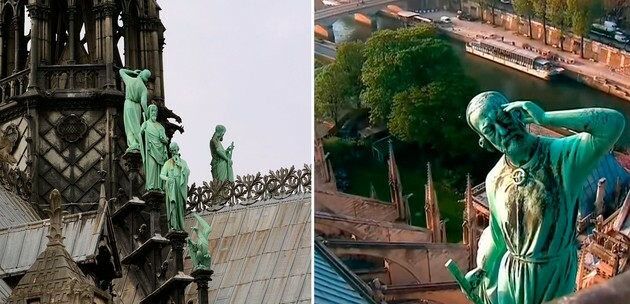
Right: Detail of a portrait of Viollet-le-Duc as Saint Thomas.
Viollet-le-Duc reproduced a series of bronze statues of the twelve apostles, who watch over the city from on high. One of them, Saint Thomas, would be Viollet-le-Duc himself who, with his back to Paris, watches over the spire. In this way, Viollet-le-Duc made himself an immortal custodian of the sacred edifice.
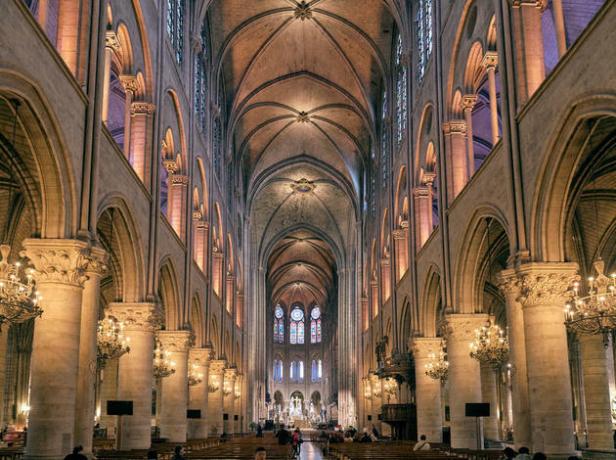
Inside the cathedral, there is a ceiling resolved with rib vaults, which are formed by crossing two pointed arches. The ribs in these vaults distribute the weight towards the columns. Thanks to this architectural technique, they managed to remove the heavy walls and open openings in them to create windows for a heavenly effect. In the previous photograph you can see the three levels of elevation of the cathedral.
Rosettes
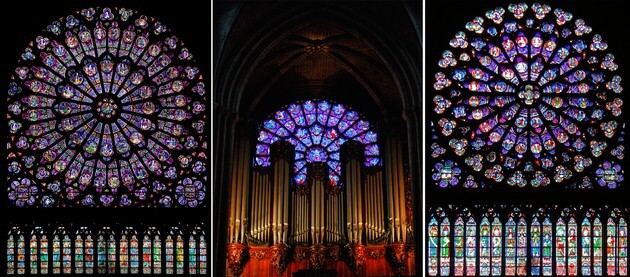
Left: rose window of the south transept.
It is not difficult to imagine the emotional impact of those colorful lights coming from the stained glass windows, at a time when the only source of interior lighting came from fire. One of the characteristic elements of Notre Dame are its beautiful rose windows, present on the western façade, on the north and south façade. The northern one would be dedicated to the Virgin Mary and the southern one would be dedicated to Jesus Christ.
Liturgical and decorative art
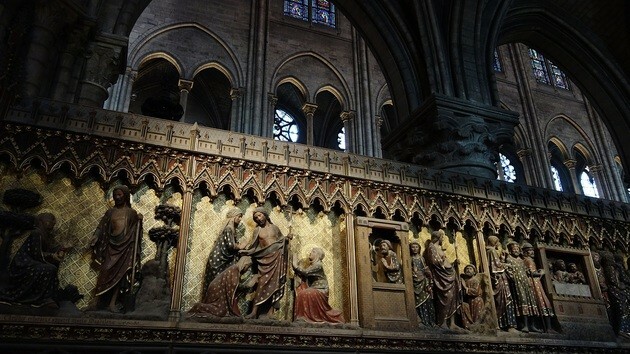
In Gothic art, sculpture and painting are at the service of architecture, and although they lack a liturgical function, they always have an educational and propagandistic function. Within the set of Notre Dame, highlights a jube, that is to say, a kind of wall that surrounds the choir and frames it within the plant. The jube is decorated with polychrome wood carvings, which relate different cycles of the life of Jesus. These were painted throughout the 14th century.
The northern section was supervised by Pierre de Chelles and deals with the life of Jesus from infancy to his passion and death. It was made between 1300 and 1318. The southern section was supervised by Jean Ravy and, on his death, by his nephew Jean le Boutellier. In it the scenes after the resurrection are represented, a theme less developed in the iconography of that time than the previous ones. It was made between 1344 and 1351.


Likewise, as part of the interpretation of the aesthetics of light, the cathedral is endowed with a collection of liturgical art in precious stones and metals, full of color and brilliance. None of them have been left in disuse, since it is considered essential to keep the reason for its existence alive.
History of Notre Dame Cathedral
The cathedral of Notre Dame Construction began in 1163 and ended in 1345. We speak of almost two centuries of tireless work, entire generations who lived in the service of this magnificent work, with no greater interest than leaving the testimony of their faith inscribed in the stone. That is exactly what gothic art is all about: an offering literally elevated to heaven.
The Ile de la Cité in Paris, the site of the cathedral, is a small island in the middle of the Seine River, which centuries ago had been a Celtic and Roman place of worship. Even there was a temple dedicated to Jupiter.
After the Christianization of Europe, a Romanesque church known as Saint Etienne was also built, but with the change culture that made the formation of cities possible, soon there was an interest in building a church according to the new time. This would be the gothic cathedral of Notre Dame.
The project was promoted by Bishop Maurice de Sully during the reign of Louis VII. It had the support of the king and the economic participation of all the social classes of Paris, thanks to which the work did not suffer interruptions. It was inspired, as was typical of the time, by the model of the Abbey of Saint Denis, where Abbot Suger had first applied the so-called "aesthetics of light", the heart of Gothic art.
Stages of construction, transformations and restorations of Notre Dame
- 1163: Start of construction.
- 1182: the cathedral begins to offer religious services at the end of the choir area.
- 1182-1200 approx.: culmination of the main nave.
- Beginning of the 13th century: construction of facades and towers.
- 1250-1267: culmination of the transept (work by Jean de Chelles and Pierre de Montreuil).
- 1250: installation of the first needle.
- 1345: end of construction.
- 1400: installation of the bell in the south tower.
- 17th century, reign of Louis XIV: destruction of the stained glass windows to replace them with baroque decoration.
- 1630-1707: elaboration of a total of 77 paintings of which only 12 have been recovered.
- 18th century, French Revolution: looting and partial destruction of the cathedral by the revolutionaries. Deterioration caused by its use as a food store. Extraction of the bells to make cannons with cast iron.
- 19th century: restoration projects by Eugène Viollet-le-Duc and Jean-Baptiste-Antoine Lassus.
- 1831, curious fact: Victor Hugo publishes the novel Our Lady of paris.
- 1856: installation of 4 new bells in the north tower.
- April 15, 2019: the cathedral suffers a devastating fire that destroys the main spire or pinnacle, the work of Viollet-le-Duc, as well as the ceiling.
